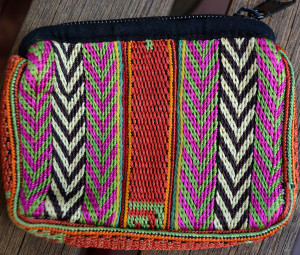Tablet Woven Complexity
 Tablet weaving can be complex indeed but to start weaving it can be one of the most enjoyable achievements out. Over the years I’ve mostly used the backstrap method to weave with the cards but I think a decent and strong inkle loom does the job better because I need to be physically ‘disconnected’ to the weaving to concentrate…at least in my household. The soft mauve and lemon band here is one of the simplest patterns in threading and turning (4/4) and the pattern magically appears with minimal effort. From Tablet Weaving – Ann Sutton and Pat Holtom.
Tablet weaving can be complex indeed but to start weaving it can be one of the most enjoyable achievements out. Over the years I’ve mostly used the backstrap method to weave with the cards but I think a decent and strong inkle loom does the job better because I need to be physically ‘disconnected’ to the weaving to concentrate…at least in my household. The soft mauve and lemon band here is one of the simplest patterns in threading and turning (4/4) and the pattern magically appears with minimal effort. From Tablet Weaving – Ann Sutton and Pat Holtom.
There are alot of people investigating and deciphering old historic patterns and much new material available for tablet weaving. The SCA movement has propelled much of this in Europe. One of the very best explanations of tablet weaving I’ve seen is here. Eva Sandermann Olsen does a remarkable job, in my view, of explaining tablet weaving in a humble yet thoroughly authoritative way. Also the long running Phalia’s String page offers alot of information. Another lovely new book is Applesies and Fox Noses from Finland. This is certainly a must have, very delightful addition to a tablet weaver’s library.

But one publication which is absolutely fascinating on many levels is the Willful Pursuit of Complexity by Kris Leet and Linda Malan on the Icelandic Vacant-Hole technique. I can’t go past the broader perspective of this publication under ‘Collateral Issues’ and I quote directly.
“First, there is the pervasive perception, by weavers as well as non-weavers, that prehistoric and early historic weaving was in some sense primitive, that it was crude, not very well done, that it lacked either elegance or sophistication or an acceptable level of craftsmanship.
What seems to be true, however, is that no matter how far back toward the genesis of weaving one travels, one encounters sophisticated techniques, skilled command of the materials, and elegant objects. Archaeologists consistently push back the dates at which they think weaving was invented because they keep finding evidence for well-developed textile production at earlier and earlier time periods. In addition, as more archaeological sites are discovered and catalogued it becomes overwhelmingly apparent that the human race has forgotten much more than it currently knows.
We are so defined by our current technology that we cannot conceive that people without our “advantages” could have produced objects that we cannot seem to reproduce.”
How wonderful that we are connected to others through time in this way, and their legacy has left us puzzles of how they existed, used and experienced time and skill. Note: There are other authorities in historical Tablet Weaving today that I haven’t mentioned but value their work in contributing to this weaving field.
